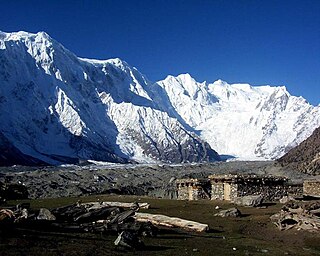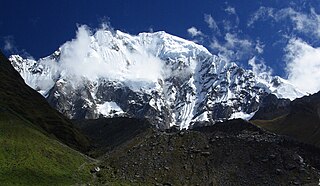Related Research Articles

Aconcagua is a mountain in the Principal Cordillera of the Andes mountain range, in Mendoza Province, Argentina. It is the highest mountain in the Americas, the highest outside Asia, and the highest in both the Western Hemisphere and the Southern Hemisphere with a summit elevation of 6,961 metres (22,838 ft). It lies 112 kilometres northwest of the provincial capital, the city of Mendoza, about five kilometres from San Juan Province, and 15 km (9 mi) from Argentina's border with neighbouring Chile. The mountain is one of the Seven Summits of the seven continents.

Nevado Ojos del Salado is a dormant complex volcano in the Andes on the Argentina–Chile border. It is the highest volcano on Earth and the highest peak in Chile. The upper reaches of Ojos del Salado consist of several overlapping lava domes, lava flows and volcanic craters, with an only sparse ice cover. The complex extends over an area of 70–160 square kilometres (27–62 sq mi) and its highest summit reaches an altitude of 6,893 metres (22,615 ft) above sea level. Numerous other volcanoes rise around Ojos del Salado.

Cerro Walther Penck is a massive complex volcano in the Andes, located in northwestern Argentina, Catamarca Province, Tinogasta Department, at the Puna de Atacama. It is just southwest of Ojos del Salado, the highest volcano in the world. Walther Penck itself is perhaps the third highest active volcano in the world.

An unclimbed mountain is a mountain peak that has yet to be climbed to the top. Determining which unclimbed peak is highest is often a matter of controversy. In some parts of the world, surveying and mapping are still unreliable. There are no comprehensive records of the routes of explorers, mountaineers, and local inhabitants. In some cases, even modern ascents by larger parties have been poorly documented and, with no universally recognized listing, the best that can be achieved in determining the world's highest unclimbed peaks is somewhat speculative. Most sources indicate that Gangkhar Puensum on the Bhutan–China border is the tallest mountain in the world that has yet to be fully summited. Gangkhar Puensum has been off limits to climbers since 1994 when Bhutan prohibited all mountaineering above 6,000 m (20,000 ft) due to spiritual/religious beliefs. An unclimbed and unnamed peak in Pakistan is 7,780 m (25,520 ft).

Huascarán, Nevado Huascarán or Mataraju is a mountain in the Peruvian province of Yungay, situated in the Cordillera Blanca range of the western Andes. The southern summit of Huascarán, which reaches 6,768 metres (22,205 ft), is the highest point in Peru, the northern Andes, and in all of the earth's Tropics. Huascarán is the fourth highest mountain in the Western Hemisphere and South America after Aconcagua, Ojos del Salado, and Monte Pissis, respectively.

Illimani is the highest mountain in the Cordillera Real of western Bolivia. It lies near the cities of El Alto and La Paz at the eastern edge of the Altiplano. It is the second highest peak in Bolivia, after Nevado Sajama, and the eighteenth highest peak in South America. The snow line lies at about 4,570 metres (15,000 ft) above sea level, and glaciers are found on the northern face at 4,983 m (16,350 ft). The mountain has four main peaks; the highest is the south summit, Nevado Illimani, which is a popular ascent for mountain climbers.

Pico Cristóbal Colón is the highest mountain in Colombia, with an estimated height of 5,730 metres (18,800 ft). Pico Cristóbal Colón and Pico Simón Bolívar are the two highest peaks in Colombia and are equal in elevation. One or the other of these peaks is therefore the fifth most prominent in the world. The nearest peak that is higher is Cayambe, some 1,288 kilometres (800 mi) away. There is a permanent snowcap on this peak and on the nearby mountains. It is part of the Sierra Nevada de Santa Marta range, along with Pico Simón Bolívar. The peak is named after Christopher Columbus.
David Lim is a Singaporean mountaineer and motivational speaker who led the first Singapore Mount Everest Expedition in 1998. Between 1994 and 1998, he led and organised a team from the flat tropical island nation to the top of Everest. Sustaining an injury on the summit push, he did not make the summit himself though two other team members succeeded in making the top on May 25, 1998. A week after his return, and not related to the climb, he was stricken with Guillain–Barré syndrome, a rare nerve disorder where the immune system attacks the peripheral nerves. Paralysed from eyes down, he spent six months in hospitals, and emerged partially disabled in both legs.

Monte Pissis is an extinct volcano on the border of La Rioja and Catamarca provinces, Argentina, 25 km (16 mi) from the Chilean border. The mountain is the third-highest in the Western Hemisphere, and is located about 550 km (340 mi) north of Aconcagua. Monte Pissis is named after Pedro José Amadeo Pissis, a French geologist who worked for the Chilean government. Due to its location in the Atacama Desert, the mountain has very dry conditions but there is an extensive glacier

Janne Corax is a Swedish cyclist, mountaineer and explorer. He has travelled in 110 countries and cycled more than 82,500 km. He lives in Målilla in southern Sweden. He is an authority on Tibet, across which he has made several long and unsupported expeditions.
Pico Simón Bolívar is the second highest mountain in Colombia, with an estimated height of 5,775 metres (18,947 ft). Pico Bolívar and the neighbouring summit of Pico Cristóbal Colón are the two highest peaks in Colombia and are very nearly equal in elevation. The difference in elevation is estimated to be only one or two metres. One or other of these peaks is therefore the fifth most prominent in the world. The nearest peak that is higher is Cayambe, some 1,288 kilometres (800 mi) away. There is a permanent snowcap on this peak and on the nearby mountains. It is part of the Sierra Nevada de Santa Marta range, along with Pico Cristóbal Colón. The peak is named after Simón Bolívar.

Johan Reinhard is an American anthropologist and archaeologist. He is Explorer-in-Residence at the National Geographic Society. He is also a senior research fellow at The Mountain Institute, a visiting professor at Catholic University, Salta, Argentina, an honorary professor of Catholic University, Arequipa, Peru, and a research professor at Future Generations University.

The Seven Second Summits are the second-highest mountains of each of the seven continents. All of these mountain peaks are separate peaks rather than a sub-peak of the continents' high point. The Seven Second Summits are considered a harder challenge than the traditional Seven Summits.

Salcantay, Salkantay or Sallqantay is the highest peak in the Vilcabamba mountain range, part of the Peruvian Andes. It is located in the Cusco Region, about 60 km (40 mi) west-northwest of the city of Cusco. It is the 38th-highest peak in the Andes and the twelfth-highest in Peru. However, as a range highpoint in deeply incised terrain, it is the second most topographically prominent peak in the country, after Huascarán.

Nevado San Francisco, or Cerro San Francisco, is a stratovolcano on the border between Argentina and Chile, located just southeast of San Francisco Pass. It is considered extinct and is one of the several 6,000 m (19,700 ft) peaks in the area, of which the chief is the Ojos del Salado. It is on the border of 2 provinces: Argentinean province of Catamarca; Chilean province of Copiapo.

Christian Stangl is an Austrian alpine style mountaineer and mountain guide. He has become known as Skyrunner by numerous exceptionally fast ascents of high mountains. His major success was in 2013, when he became the first person to ascend the three highest mountains on all seven continents, the so-called Triple Seven Summits.

Jirishanca is a 6,094-metre-high (19,993 ft) mountain in the Huayhuash mountain range in west central Peru, part of the Andes. Other sources cite a height of 6,125 metres (20,095 ft). It is the tenth highest peak in Peru and the third in the Huayhuash range. Jirishanca translates as "hummingbird bill peak".
Karjiang is a mountain in Tibet Autonomous Region, located near the Bhutan–Tibet border. The highest peak of the Karjiang group is Karjiang I or Karjiang South, with an elevation of 7,221 metres (23,691 ft); it remains unclimbed. Other peaks include Karjiang North, Karjiang II/Central, Karjiang III or Taptol Kangri and the top of the north-eastern shoulder.
Maximo Kausch is a British mountain guide and expedition leader. He holds the current world record of the most 6,000-metre Andean peaks climbed.
Nevado de Famatina is a peak in Argentina with an elevation of 6,115 metres (20,062 ft) metres. It is the highest point of Sierra de Famatina. It is located within the territory of the Argentinean province of La Rioja. Its slopes are within the administrative boundaries of the Argentinean cities: Famatina and Chilecito.
References
- ↑ "British Climber Discovers High Altitude Inca Ruins". TheBMC. Retrieved 26 January 2021.
- ↑ "Ojos del Salado". Andes Website. Retrieved 26 January 2021.
- ↑ Biggar, John (1996). The High Andes (1st ed.). Menasha Ridge Press. ISBN 1-871890-38-1.
- ↑ Susan Jensen & Ed Douglas, ed. (2015). Alpine Journal. The Alpine Club. p. 394. ISBN 978-0-9569309-4-1.
- ↑ John Harlin III, ed. (2006). American Alpine Journal. The American Alpine Club. p. 252. ISBN 1-933056-01-0.
- ↑ "British Climb South American Virgin". TheBMC. Retrieved 26 January 2021.
- ↑ John Harlin III, ed. (2012). American Alpine Journal. The American Alpine Club. p. 176. ISBN 978-1-933056-75-3.
- ↑ Bracali, Dario (2012). 6500+. Ediciones Vertical. ISBN 978-987-33-2417-8.
- ↑ "Andes Top 10". estiloandino. Retrieved 14 August 2021.
- ↑ "Cristobal Colon". Petter Bjorstad. Retrieved 14 July 2020.